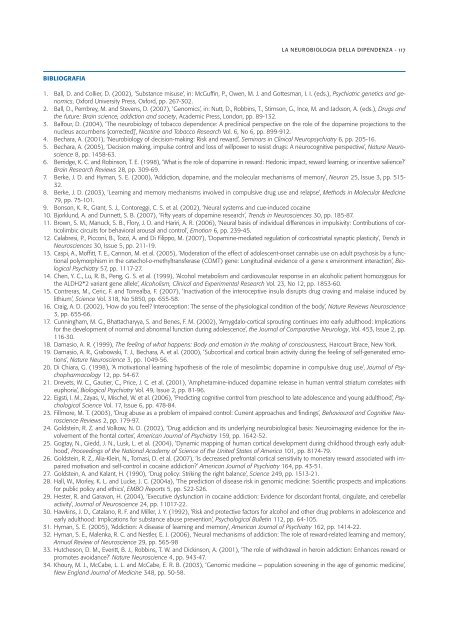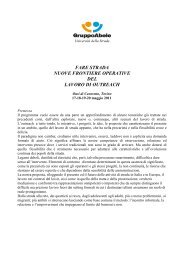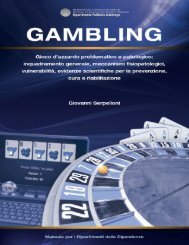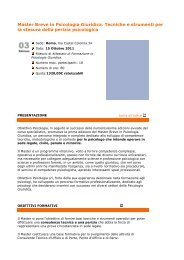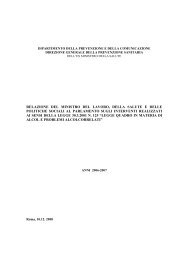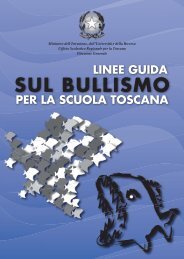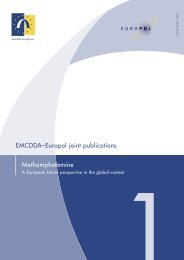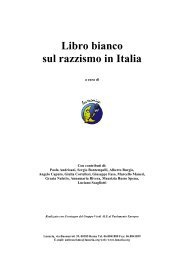Neuroscienze e dipendenze - Dipartimento per le politiche antidroga
Neuroscienze e dipendenze - Dipartimento per le politiche antidroga
Neuroscienze e dipendenze - Dipartimento per le politiche antidroga
You also want an ePaper? Increase the reach of your titles
YUMPU automatically turns print PDFs into web optimized ePapers that Google loves.
LA NEUROBIOLOGIA DELLA DIPENDENZA - 117<br />
BIBLIOGRAFIA<br />
1. Ball, D. and Collier, D. (2002), ‘Substance misuse’, in: McGuffin, P., Owen, M. J. and Gottesman, I. I. (eds.), Psychiatric genetics and genomics,<br />
Oxford University Press, Oxford, pp. 267-302.<br />
2. Ball, D., Pembrey, M. and Stevens, D. (2007), ‘Genomics’, in: Nutt, D., Robbins, T., Stimson, G., Ince, M. and Jackson, A. (eds.), Drugs and<br />
the future: Brain science, addiction and society, Academic Press, London, pp. 89-132.<br />
3. Balfour, D. (2004), ‘The neurobiology of tobacco dependence: A preclinical <strong>per</strong>spective on the ro<strong>le</strong> of the dopamine projections to the<br />
nuc<strong>le</strong>us accumbens [corrected]’, Nicotine and Tobacco Research Vol. 6, No 6, pp. 899-912.<br />
4. Bechara, A. (2001), ‘Neurobiology of decision-making: Risk and reward’, Seminars in Clinical Neuropsychiatry 6, pp. 205-16.<br />
5. Bechara, A. (2005), ‘Decision making, impulse control and loss of willpower to resist drugs: A neurocognitive <strong>per</strong>spective’, Nature Neuroscience<br />
8, pp. 1458-63.<br />
6. Berridge, K. C. and Robinson, T. E. (1998), ‘What is the ro<strong>le</strong> of dopamine in reward: Hedonic impact, reward <strong>le</strong>arning, or incentive salience’<br />
Brain Research Reviews 28, pp. 309-69.<br />
7. Berke, J. D. and Hyman, S. E. (2000), ‘Addiction, dopamine, and the mo<strong>le</strong>cular mechanisms of memory’, Neuron 25, Issue 3, pp. 515-<br />
32.<br />
8. Berke, J. D. (2003), ‘Learning and memory mechanisms involved in compulsive drug use and relapse’, Methods in Mo<strong>le</strong>cular Medicine<br />
79, pp. 75-101.<br />
9. Bonson, K. R., Grant, S. J., Contoreggi, C. S. et al. (2002), ‘Neural systems and cue-induced cocaine<br />
10. Bjorklund, A. and Dunnett, S. B. (2007), ‘Fifty years of dopamine research’, Trends in Neurosciences 30, pp. 185-87.<br />
11. Brown, S. M., Manuck, S. B., Flory, J. D. and Hariri, A. R. (2006), ‘Neural basis of individual differences in impulsivity: Contributions of corticolimbic<br />
circuits for behavioral arousal and control’, Emotion 6, pp. 239-45.<br />
12. Calabresi, P., Picconi, B., Tozzi, A. and Di Filippo, M. (2007), ‘Dopamine-mediated regulation of corticostriatal synaptic plasticity’, Trends in<br />
Neurosciences 30, Issue 5, pp. 211-19.<br />
13. Caspi, A., Moffitt, T. E., Cannon, M. et al. (2005), ‘Moderation of the effect of ado<strong>le</strong>scent-onset cannabis use on adult psychosis by a functional<br />
polymorphism in the catechol-o-methyltransferase (COMT) gene: Longitudinal evidence of a gene x environment interaction’, Biological<br />
Psychiatry 57, pp. 1117-27.<br />
14. Chen, Y. C., Lu, R. B., Peng, G. S. et al. (1999), ‘Alcohol metabolism and cardiovascular response in an alcoholic patient homozygous for<br />
the ALDH2*2 variant gene al<strong>le</strong><strong>le</strong>’, Alcoholism, Clinical and Ex<strong>per</strong>imental Research Vol. 23, No 12, pp. 1853-60.<br />
15. Contreras, M., Ceric, F. and Torrealba, F. (2007), ‘Inactivation of the interoceptive insula disrupts drug craving and malaise induced by<br />
lithium’, Science Vol. 318, No 5850, pp. 655-58.<br />
16. Craig, A. D. (2002), ‘How do you feel Interoception: The sense of the physiological condition of the body’, Nature Reviews Neuroscience<br />
3, pp. 655-66.<br />
17. Cunningham, M. G., Bhattacharyya, S. and Benes, F. M. (2002), ‘Amygdalo-cortical sprouting continues into early adulthood: Implications<br />
for the development of normal and abnormal function during ado<strong>le</strong>scence’, the Journal of Comparative Neurology, Vol. 453, Issue 2, pp.<br />
116-30.<br />
18. Damasio, A. R. (1999), The feeling of what happens: Body and emotion in the making of consciousness, Harcourt Brace, New York.<br />
19. Damasio, A. R., Grabowski, T. J., Bechara, A. et al. (2000), ‘Subcortical and cortical brain activity during the feeling of self-generated emotions’,<br />
Nature Neuroscience 3, pp. 1049-56.<br />
20. Di Chiara, G. (1998), ‘A motivational <strong>le</strong>arning hypothesis of the ro<strong>le</strong> of mesolimbic dopamine in compulsive drug use’, Journal of Psychopharmacology<br />
12, pp. 54-67.<br />
21. Drevets, W. C., Gautier, C., Price, J. C. et al. (2001), ‘Amphetamine-induced dopamine re<strong>le</strong>ase in human ventral striatum correlates with<br />
euphoria’, Biological Psychiatry Vol. 49, Issue 2, pp. 81-96.<br />
22. Eigsti, I. M., Zayas, V., Mischel, W. et al. (2006), ‘Predicting cognitive control from preschool to late ado<strong>le</strong>scence and young adulthood’, Psychological<br />
Science Vol. 17, Issue 6, pp. 478-84.<br />
23. Fillmore, M. T. (2003), ‘Drug abuse as a prob<strong>le</strong>m of impaired control: Current approaches and findings’, Behavioural and Cognitive Neuroscience<br />
Reviews 2, pp. 179-97.<br />
24. Goldstein, R. Z. and Volkow, N. D. (2002), ‘Drug addiction and its underlying neurobiological basis: Neuroimaging evidence for the involvement<br />
of the frontal cortex’, American Journal of Psychiatry 159, pp. 1642-52.<br />
25. Gogtay, N., Giedd, J. N., Lusk, L. et al. (2004), ‘Dynamic mapping of human cortical development during childhood through early adulthood’,<br />
Proceedings of the National Academy of Science of the United States of America 101, pp. 8174-79.<br />
26. Goldstein, R. Z., Alia-K<strong>le</strong>in, N., Tomasi, D. et al. (2007), ‘Is decreased prefrontal cortical sensitivity to monetary reward associated with impaired<br />
motivation and self-control in cocaine addiction’ American Journal of Psychiatry 164, pp. 43-51.<br />
27. Goldstein, A. and Kalant, H. (1990), ‘Drug policy: Striking the right balance’, Science 249, pp. 1513-21.<br />
28. Hall, W., Mor<strong>le</strong>y, K. L. and Lucke, J. C. (2004a), ‘The prediction of disease risk in genomic medicine: Scientific prospects and implications<br />
for public policy and ethics’, EMBO Reports 5, pp. S22-S26.<br />
29. Hester, R. and Garavan, H. (2004), ‘Executive dysfunction in cocaine addiction: Evidence for discordant frontal, cingulate, and cerebellar<br />
activity’, Journal of Neuroscience 24, pp. 11017-22.<br />
30. Hawkins, J. D., Catalano, R. F. and Mil<strong>le</strong>r, J. Y. (1992), ‘Risk and protective factors for alcohol and other drug prob<strong>le</strong>ms in ado<strong>le</strong>scence and<br />
early adulthood: Implications for substance abuse prevention’, Psychological Bul<strong>le</strong>tin 112, pp. 64-105.<br />
31. Hyman, S. E. (2005), ‘Addiction: A disease of <strong>le</strong>arning and memory’, American Journal of Psychiatry 162, pp. 1414-22.<br />
32. Hyman, S. E., Ma<strong>le</strong>nka, R. C. and Nest<strong>le</strong>r, E. J. (2006), ‘Neural mechanisms of addiction: The ro<strong>le</strong> of reward-related <strong>le</strong>arning and memory’,<br />
Annual Review of Neuroscience 29, pp. 565-98<br />
33. Hutcheson, D. M., Everitt, B. J., Robbins, T. W. and Dickinson, A. (2001), ‘The ro<strong>le</strong> of withdrawal in heroin addiction: Enhances reward or<br />
promotes avoidance’ Nature Neuroscience 4, pp. 943-47.<br />
34. Khoury, M. J., McCabe, L. L. and McCabe, E. R. B. (2003), ‘Genomic medicine — population screening in the age of genomic medicine’,<br />
New England Journal of Medicine 348, pp. 50-58.


